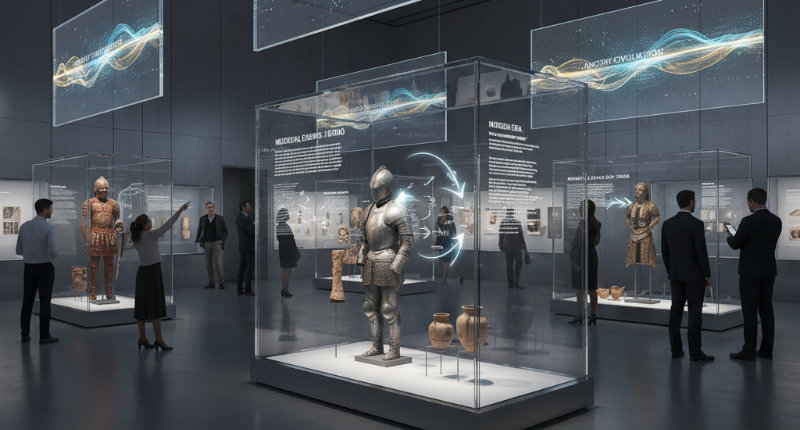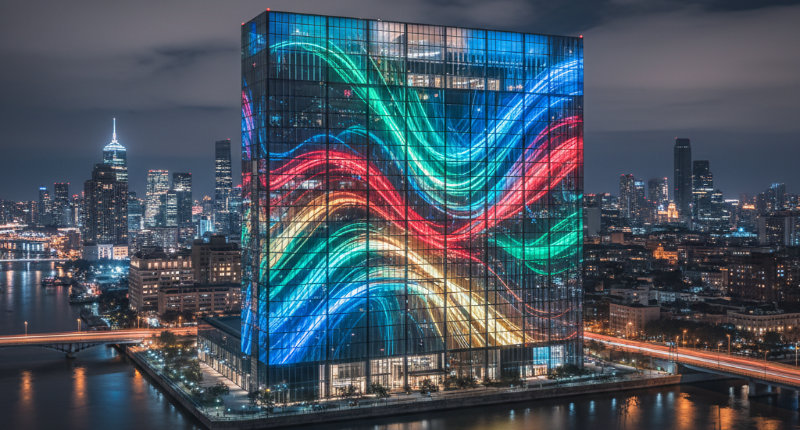Holographic transparent LED screens combine the clarity of glass with the dynamic presence of digital media, allowing light to pass through while still producing vivid images. When used thoughtfully, they turn architectural surfaces into storytelling canvases that never feel closed off or opaque.
Whether guiding shoppers through a store, engaging museum visitors in a hall, animating audience anticipation in a theater, or animating a city’s skyline on a building curtain wall, the technology thrives when the space is light, the content is tailored, and the experience is not just visible but felt.
What Is a Holographic Transparent LED Screen?
At its core, a holographic transparent LED screen is a lattice of light-emitting diodes mounted on a transparent substrate, with high-percentage open areas so that ambient light and viewlines can pass through. When the screen is ‘off’, it looks much like clear glass. When it’s ‘on’, micro-LEDs create colors and motion across a narrow visual plane that appears suspended in the transparent medium. This gives an ethereal, floating effect akin to an image hovering behind a window.
In practical terms, the screen isn’t truly a hologram, but it mimics the effect by combining transparency with light in a way that feels like an optical illusion. Reason: Transparent LEDs work with light and transparency to create an impression of depth, which people perceive as ‘holographic’.
Why Transparent LEDs Are Special
1.They let daylight or interior lighting continue, preserving the original spatial openness. Reason: High open-area ratios minimize obstruction of light and sightlines.
2.They are bright enough to read even in mixed light conditions, which matters for retail and wayfinding. Reason: High luminance and contrast keep visuals legible in variable lighting.
3.They add a low-mass, ‘non-bulky’ digital layer to glass, avoiding the heaviness of opaque displays. Reason: Thin modular panels integrate into glazing without bulky frames.
4.They are seen as ‘alive’ media surfaces in architectural settings, making walls feel interactive without requiring touch. Reason: The floating imagery engages passersby in a subtle, glance-friendly way.
Transparent LEDs vs Other Display Technologies
Unlike conventional LED walls, projection on glass, or AR smart glasses, transparent LEDs sit directly in your field of view as a physical layer. They deliver content at a fixed optical distance, which makes the effect more stable for group viewing. In contrast, projection can wash out in bright rooms or require a dark environment; AR devices depend on users wearing hardware and maintain “immersion” individually rather than collectively. Transparent LEDs win when you want a shared experience inside a real space—present to all, readable in daylight, and naturally part of the architecture.
| Technology | 가장 적합한 | Pros | Cons | Typical Cost Band |
| Transparent LED | Shared public spaces, architectural glazing | Works in daylight, preserves transparency, modular | Less dense pixel options, requires careful glare control | Medium–High |
| Projection on Glass | Temporary events, dynamic textures | High flexibility, easy to swap content | Needs darkened or controlled light to maintain contrast | Medium |
| AR/VR Wearables | Individual immersion, data overlays | Interactive, personalized, motion tracking | Requires device adoption, can fatigue users | High (hardware) |
| Conventional LED Wall | Large outdoor, stage backdrops | High pixel density, bright | Obstructs view, needs dark surrounds for readability | Medium–High |
| LCD Tiles (Transparent) | Controlled light interiors | Sharp text, good for signage | Limited transparency ratios, not ideal for daylight | Medium |
Applications in Stores
In retail, transparent LEDs act like ‘digital windows’ that can morph from pure glass to full storytelling within seconds.
In storefronts, a living window can showcase brand values, limited-time offers, or product launches without hiding the world outside. Inside, they serve as dividers, counters, and feature walls that let shoppers peek through while absorbing narratives, such as the craftsmanship behind a craft beer or the sourcing story of a coffee bean. The atmosphere remains airy, inviting, and free of visual heaviness. Transparent displays are lightweight and blend with glass, keeping retail spaces bright and welcoming.
Consider a fashion store that turns its entrance into a runway during events; the transparent LED wall behind the mannequins can play the latest lookbook while people continue to walk through. Content can run in real-time without blocking traffic flow, supporting both spectacle and function.
Applications in Exhibition Halls
Museums and galleries benefit from transparent LEDs because they respect the presence of artifacts and surfaces.
A transparent film can display a historical timeline across a glass case or show a scientific diagram that overlays a physical object, turning the object into a focal point while enriching it with context. Visitors feel the object’s reality and the story in a single view. Transparency preserves the authenticity of the object while layering interpretive information.
In temporary exhibits, modular panels can be reconfigured as narratives evolve, and the screens can be controlled to ‘fade’ when not needed, keeping the space minimal and uncluttered. Modular flexibility makes it easy to adapt content and preserve the gallery’s aesthetic.
Applications in Theaters
In theaters, transparent LEDs can step into the role of ‘creative canvas’ that sits between the audience and the stage. They can suggest depth and set pieces without using heavy physical constructs.
Imagine a play about ocean storms; the screen can be glass-clear when the scene is quiet, then shift to a transparent wave animation that seems to crash on stage. Because the screen is open, it can coexist with front lighting without significantly dimming the overall room. Transparent media integrates with stage lighting better than opaque displays, keeping the space feeling live and luminous.
For the orchestra pit, the screen can be configured to ‘vanish’ after a performance, so the theater’s ambiance returns to neutral for the next show. The ability to dim or fade the visual layer maintains a flexible performance environment.
Applications in Building Curtain Walls
On large façades, transparent LEDs bring the cityscape to life without turning the building into an opaque box.
By day, the façade remains predominantly glass, maintaining thermal and visual performance. By night, the wall can become a shimmering display that animates the skyline, shows public art, or communicates civic messages. It’s ideal for corporate headquarters that want to be digital landmarks or for cities aiming to host ‘lights’ events with architectural participation.
Transparent technology aligns with the building’s function of admitting light and providing views while unlocking new visual communication.
Underlying Principles in Simple Terms
Transparent LED screens rely on several core principles:
1. the light emitters are small and spaced apart on a transparent substrate; this creates a grid of pixels with open areas that let light and view pass.
2., the visual plane is close to the surface, so the eye perceives images as hovering within the glass.
3. color and motion are generated by driving these tiny LEDs at high refresh rates, making the animation smooth and preventing flicker.
4. reflectance and anti-glare treatments can be added to manage external brightness.
These factors determine how the screen appears in different environments and how it feels to viewers. To think of it simply, it’s like having a window that can produce an animated film when you ‘turn the window on’ and when you ‘turn it off’ it remains a normal window.
Why Transparency Reduces Black Performance
The substrate’s transparency means some light passes through the screen instead of being absorbed. In bright conditions, this can wash out the ‘blacks’ in the image, making contrast more dependent on the content design and on managing surrounding light. More light passing through reduces the ability of the screen to create deep blacks.
To compensate, content can use brighter images, more contrast, and careful color choices. For instance, highlights on reflective surfaces can ‘sparkle’ on transparent glass, producing a distinctive look that may be more eye-catching than a conventional wall. A bright, high-contrast approach is effective when the substrate is open and light-rich.
Design and Implementation Considerations
1.Pixel Pitch and Viewing Distance: Wider pitch panels suit farther viewing distances, such as façades; closer pitch suits detailed content in stores.
Reason: Pixel density and distance determine how sharp content looks.
2.Luminance and Contrast: Set brightness relative to ambient light; always test with real content during the day and at night.
Reason: Environments change, and content must adapt.
3.Transparency Ratios: Choose panels with higher open-area ratios for maximum clarity, balancing transparency with the visual effect you want.
Reason: Open area directly affects how ‘clear’ the screen feels.
4.Power and Thermals: Plan power and heat management early, especially for large curtain walls.
Reason: LED arrays consume energy and generate heat that must be controlled.
5.Integration with Glazing: Ensure compatible mounting with curtain wall systems, and align with the building’s energy and safety codes.
Reason: The screen is part of the façade; it must meet structural, thermal, and fire standards.
6.Content Workflow: Maintain a pipeline for content creation, scheduling, and updates; use modular segments to support changes.
Reason: Transparent LED projects benefit from flexible, organized content management.
7.Control and Automation: Implement day-night dimming, weather-based content changes, and scheduled animations.
Reason: Automated control keeps the experience positive for communities and reduces light pollution.
Content Strategy for Each Use Case
1.Stores: Use narrative arcs—product origins, craftsmanship, seasonal collections—layered subtly so the space remains social and calm.
Reason: Shoppers value ambiance; visual content should enhance, not overwhelm.
2.Exhibition Halls: Treat each panel like a contextual footnote; avoid dense text; let imagery complement objects rather than replace them.
Reason: Artifacts should remain central, with digital layers in supportive roles.
3.Theaters: Align visuals with lighting cues; keep screens transparent for dialog-heavy scenes, then animate when atmosphere needs heightening.
Reason: The screen’s presence must support the story, not distract from it.
4.Building Curtain Walls: Curate city-friendly visuals, limit flashing or rapid motion, and schedule content to community rhythms.
Reason: Shared urban spaces require considerate, respectful content.
5.General Advice: Use gradients, abstract motion, and high-contrast highlights that translate well to transparent media.
Reason: The materials respond better to light and reflection than to dense, dark text-heavy content.
Common Misconceptions and How to Avoid Them
1.“Holographic means true 3D.” Most systems are transparent LEDs with a floating effect, not a volumetric hologram. Reason: A transparent layer produces the appearance of depth but not a full 3D hologram.
2.“It’s just a screen on glass.” The content must be authored for transparency to feel natural; an opaque layout will look constrained. Reason: Transparent media requires new content strategies to realize its unique aesthetic.
3.“It works in any lighting.” Without glare control or content adaptation, daytime contrast can suffer. Reason: Transparent screens are influenced by ambient conditions and need careful design.
Quick Scenario Comparison
| Use Case | Primary Goal | Content Type | Viewing Distance | Special Considerations |
| Storefront Windows | Brand storytelling and draw | Highlights, motion gradients | Close–Mid | 일광 가독성과 투명성의 균형 |
| 매장 파티션 | 주변 환경 향상 | 미묘한 애니메이션 | 닫다 | 개인정보 보호 및 고객 편의성 보장 |
| 전시장 | 컨텍스트 오버레이 | 과학적 시각 자료, 타임라인 | 닫다 | 유물의 진위성을 존중하고 텍스트는 최소화합니다. |
| 연극 배경 | 몰입감 넘치는 분위기 | 서사적 환상 | 중간 | 무대 조명 및 장면 페이싱과 통합 |
| 건물 커튼월 | 시민 소통 | 도시 예술, 브랜드 영화 | 멀리 | 야간 조광, 커뮤니티 일정, 에너지 계획 |
In Summary
홀로그램 투명 LED 스크린은 공간이 개방적이어야 하고, 콘텐츠가 유리라는 현실을 넘어 떠 있어야 하며, 개인이 아닌 많은 사람과 경험을 공유해야 할 때 탁월한 효과를 발휘합니다. 홀로그램은 매장을 매력적으로, 전시를 유익하게, 극장을 분위기 있게, 파사드를 환하게 만들어줍니다.
마법이 아니라, 빛, 투명성, 그리고 사려 깊은 콘텐츠 디자인의 섬세한 조합입니다. 가장 성공적인 프로젝트는 재료의 특성을 인간의 지각에 맞추고, 환경의 다양성을 고려하며, 화면을 공간의 대체물이 아닌 참여자로 취급합니다.
현명하게 사용하면 건축물을 원래 목적, 즉 세상을 향한 창문이라는 목적을 잃지 않고도 살아있는 캔버스로 바꿀 수 있습니다!






